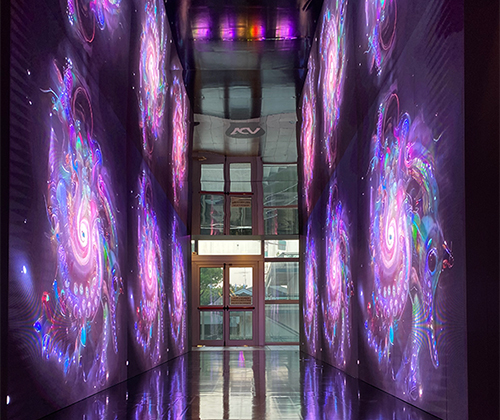
Immersive Tunnel
An exceptional 9-meter display composed of large LED walls that viewers can traverse, experiencing an immersive and astonishing journey.
The tunnel represents a Stargate between the physical and digital worlds, symbolizing a journey through time, encompassing present, past, and future, presenting the diverse meanings conveyed by the works of artists Leonardo Petrucci, Pamela Diamante, and Matteo Basilè, alternating during the two days of the Convention.
by Pamela Diamante

by Leonardo Petrucci
VORTEXY is a loop animation of the M51 galaxy, also known as the Whirlpool Galaxy, rapidly transformed into a collection of cephalopods through Artificial Intelligence software.
The spiral motion adds to an enlargement of the galaxy's nucleus until it becomes a sea of black ink and eventually a marine landscape. The point of contact between the universe and the depths is the key to understanding much of Petrucci's research, closely tied to the alchemical world.

by Matteo Basilè
Two videos contain a set of digital paintings linked to the theme of Celeritas, understood as an ode to slowness on one hand and speed on the other, where a perfect balance between human communication and technology is found, reliving together in simple and ancient gestures like an embrace, a smile, a gaze, or a light touch.
Today, more than ever, there is a need for love, beauty, and stories that speak of us. We Italians, who every day transform into poets and navigators, between hashtags and megabytes traveling on digital highways; we who with our history redefine the human map of an ancient civilization projected into the future; we who need to remain connected to life always, everywhere, and better. Basilé titles these works for VDA with the formula 'C0', which, through the theory of special relativity, indicates the maximum speed at which all information can travel in the universe. Faced with these paintings at 600 frames per second, one is struck by the rarefied and timeless atmospheres, where the characters are immortalized in that unique and unrepeatable moment of meeting, bidding farewell, and getting emotional.

The Artists
Grosseto, 1986

Pamela Diamante
Bari, 1985

Rome, 1974
Exploring the nature of human beings, the artist develops a narrative divided into successive chapters: What remains of the Transavanguardia (2006), The Saints are Coming (2007), Thisoriented (2009), Thishumanity (2010), Landing (2012), Unseen (2014), Pietra Santa (2016), Journey to the Center of the Earth (2017) Stardust (2018), Memento (2019), Mnemosyne (2021) Hybrida (2022).
A series of independent passages in which the artist confronts his perception of existence.
Basilé's research evolves as an interface between East and West (the artist lived almost 8 years in Southeast Asia), in a dialectic that operates as a situated collision between tradition and modernity, between sacred and profane. In this way, Basilé's glossary is based not only on signs and values (however timeless and multicultural) but also encompasses a totalitarian language where the union between dream, fantasy, and reality is no longer just the subject of the photographic shot but embodies a universally recognizable and limitless narrative. His profound exploration of the Self, the Other, and the Elsewhere not only deeply corresponds to his personal life experience but also simultaneously addresses the meaning of existence within the dynamics defining the modern process of globalization. He lives and works in Rome. His extensive exhibition activity consists of numerous solo and group exhibitions presented from 1994 to today, at art galleries, museums, and institutional venues in Italy and abroad. In 2009, he was one of the artists invited to exhibit at the Italian Pavilion for the 53rd Venice Biennale. In 2008, he was invited to the 15th Rome Quadriennale.

Collective work
This research requires him to delve into highly diverse themes and disciplines. Each time he adds a new layer of research, the artist must necessarily structure a work process from scratch, which leads him to significantly expand his range of scientific and technical knowledge. This includes studies on the applied evolution of phylogenetic trees or the construction of hypothetical natural forms emerging from the fusion of real elements, to examining the arrangement of atomic bonds in molecules related to plant coloring.
This degree of multidisciplinarity leads him to have a highly heterogeneous approach to the subject and to experiment with different materials.
The resulting works have a strong technological component but are always linked to a certain iconographic tradition.
In recent years, the focus has been on natural forms derived from data acquisition and, in general, on themes that develop and bring out the strengths of form in an evolutionary and universal context.
